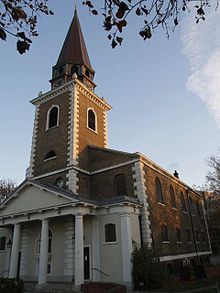St Mary's Church, Battersea
| St Mary's Church, Battersea | |
|---|---|
 View of the front of the church | |
 | |
| Location | Battersea Church Road, Battersea, Greater London, SW11 3NA |
| Country | England |
| Denomination | Church of England |
| Churchmanship | Inclusive Central |
| Website | Church website |
| History | |
| Status | Active |
| Founded | c.800 AD |
| Architecture | |
| Functional status | Parish church |
| Heritage designation | Grade I listed |
| Completed | 1777 |
| Administration | |
| Diocese | Diocese of Southwark |

St Mary's Church, Battersea, is the oldest of the churches in Battersea in the London Borough of Wandsworth, in the inner south-west of the UK's capital city.[1] Its parish shared by three Anglican churches is in the diocese of Southwark. Christians have worshipped at the site continuously since around 800 AD. It is a Grade I listed building for its combined heritage and architectural merit.[2]
History
St. Mary's is among the earliest five documented Christian holy sites south of the River Thames in London, historically in Surrey, in the Diocese of Winchester. The original church was built around 800 AD, and the present building was completed in 1777.[2] It was designed by Joseph Dixon, a local architect.[3]
The church is built of brick, with stone used for quoins and other dressings. It consists of a nave, rectangular in plan, an apse at the east end forming the sanctuary, and a west tower. The west front has a single storey entrance porch with Tuscan columns supporting a pediment. The tower, rising immediately behind it, is topped with a clock chamber and a small spire. Inside, the whole width of the church is spanned by a flat ceiling, and there are wooden galleries supported by columns on three sides. The nave windows are in two tiers, the upper ones round-headed.[3][4]
The church has strong connections with art and literature through the artist and poet William Blake, who married Catherine Boucher there on 17 August 1782,[5] and J. M. W. Turner, who painted the river from the vestry window.
Notable interments
- Benedict Arnold and his family are buried in the crypt.[6]
- John Inglis (bishop)
- Sir Rupert George
References
- ^ "St Mary's Church Battersea". London Borough of Wandsworth. Retrieved 18 February 2020.
- ^ a b "Church of St Mary and Churchyard Wall and Gates". British Listed Buildings. Retrieved 7 February 2015.
- ^ a b "St Mary, Battersea". Diocese of Southwark. Retrieved 1 June 2015.
- ^ Cherry, Bridget; Pevsner, Nikolaus (1983). London 2: South. Buildings of England. Yale University Press. p. 688. ISBN 978-0300096514. Retrieved 18 February 2020.
- ^ "St Mary's Battersea". Tate. Retrieved 2 June 2015.
- ^ Wallace, Audrey (5 March 2003). Benedict Arnold: Misunderstood Hero?. Burd Street Press. ISBN 978-1572493490 – via Google Books.
External links
![]() Media related to St. Mary's Church, Battersea at Wikimedia Commons
Media related to St. Mary's Church, Battersea at Wikimedia Commons
- St Mary's Church website
- "Stained glass virtual tour". Archived from the original on 18 February 2012.
Stefan Hopkinson, the Vicar of Battersea during the Second World War: ... There was considerable damage, but the church was unharmed -- at least, until I picked up a stone and smashed all the [very bad] Victorian glass.
- 9th-century establishments in England
- 9th-century church buildings in England
- Churches completed in 1777
- 18th-century Church of England church buildings
- Grade I listed churches in London
- Church of England church buildings in the London Borough of Wandsworth
- Anglican Diocese of Southwark
- William Blake
- Rebuilt churches in the United Kingdom
- Churches on the Thames
- Buildings and structures in Battersea
- Religious buildings and structures completed in 800
